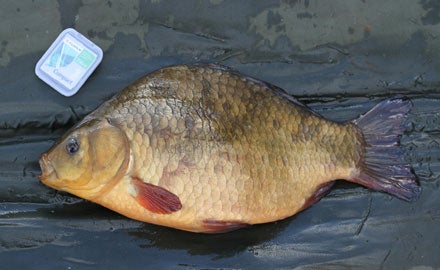THE PROBLEM OF DISTINGUISHING true specimens from hybrids has haunted the British Record Fish Committee for many years, especiallyly claims for Crucian Carp, Roach, Rudd and Silver Bream.
With UK freshwater anglers being conservation minded and wanting to return their quarry unharmed the BRFC has had only one option for establishing whether a potential record fish was pure bred. An expert would study photographs of the fish and deduce from these whether its shape, colouration, scale counts and fin ray counts, etc, indicated that it was a hybrid or a true specimen. Unfortunately, identification by this method is rather inaccurate and its use has led to a number of rather regrettable mistakes.
A true, DNA tested Crucian Carp caught from a water where hybrids of Crucian Commons
and Brown Goldfish DO exist (click for bigger picture)
Now at last it seems that a solution to the identification problem may be at hand. Practical DNA testing has arrived and it may well prove useful and interesting for testing fish other than just potential records.
It was possible to DNA test forty years ago but the tests required samples that could only be obtained by killing the fish. In more recent times it has become possible to test from much smaller, non-invasive, samples. Now, the only remaining barrier to the use of DNA testing for checking for hybrids was the establishment of genetic profiles so that a fish could be tested sufficiently accurately.


Andy Nellist, the driving force behind
the introduction of DNA testing of
potential record fish
Nearly four years ago I put the BRFC in touch with a doctor of fish biology who had been involved in several studies of UK cyprinid populations. He and his university were prepared to set up a research project to define the protocols for the major hybridising species but needed sponsorship and so I set about obtaining that. With pledges for the initial funding in place from FISHINGmagic and other donors the project never took off because I was unable to convince the BRFC that once the protocols had been defined it would be practical to obtain samples and test them. That should not be seen as a criticism of the committee since it is fundamental to the role of the BRFC that they should be sceptical of anything that is not proven to their satisfaction.
Two years ago Dr Bernd Hänfling, a Research Fellow at the University of Hull Molecular Ecology and Fisheries Genetics Laboratory, and himself a keen fisherman, led a study for the Environment Agency looking at Crucian Carp populations: “A molecular approach to detect hybridisation between native crucian carp (Carassius carassius) and related alien species (Carassius auratus and Cyprinus carpio) in UK waters” that attracted a fair bit of publicity at the time because it highlighted significant problems associated with hybridisation within Crucian Carp populations.
A true, DNA tested Crucian Carp caught from a water where hybrids of Crucian Commons and Brown Goldfish DO exist (click for bigger picture)
In conducting the study Bernd and his team developed protocols for distinguishing true Crucians from their hybrids with Brown Goldfish and Common Carp. I spoke to Bernd and was amazed to hear that sufficient DNA could now be obtained from a fin clip just 2mm x 2mm and we talked of the possibility of doing a field trial.
Earlier last year I met with Marsh Pratley who sits on the BRFC and we discussed at length the practicality of DNA testing. Graham Marsden and I also subsequently met up with Barrie Rickards who is president of the SAA and Mike Heylin the SAA Chairman. For those of you who are not aware Marsh and Phil Smith are appointed to the BRFC by the SAA.


Dr Bernd Haenfling
What came of those meetings was that it was agreed that I would organise a field trial on behalf of the SAA appointees to the BRFC. I discussed the idea with Bernd and he agreed to carry out DNA tests on samples which I would provide. Bernd would be given no information regarding the samples until after he had completed testing and published his results. We were keen to look at different sample types and also to establish how carefully the sample would have to be stored once collected.
Graham and Mark Wintle agreed to help collect samples. We decided that to verify what types of samples would provide sufficient DNA we should obtain a range of samples and store them in different ways as follows:
- Dried fin clip
- Frozen fin clip
- Fin clip stored immediately in ethanol
- Dried scale
- Frozen scale
- Scale stored immediately in ethanol
- Mucus swipe on a cotton bud stored immediately in ethanol
Eleven samples were then collected and supplied to Bernd for testing as follows:
| LABEL | NATURE OF SAMPLE |
| PV01 | Mucus swipe on a cotton bud stored immediately in ethanol |
| PV02 | Dried 1 |
| PV03 | Mucus swipe on a cotton bud stored immediately in ethanol |
| PV04 | Frozen 4 |
| PV05 | Dried 2 |
| PV06 | Frozen 3 |
| KV01 | Frozen Scale |
| GM01 | Scale dried and then frozen |
| GM02 | Frozen Scale |
| WD01 | Fin Clip stored immediately in ethanol |
| WD02 | Fin Clip stored immediately in ethanol |
All of the samples that were not initially stored in ethanol were placed in phials of ethanol before being sent to Bernd. The phials contained only the labels and no other information was provided. All but two of the fish (used as a control) sampled appeared to be Crucian Carp but they came from a variety of waters across the country and there were samples from two different waters that contained obvious hybrids.
When the results came back we were extremely pleased to find that all of the samples provided sufficient DNA to establish the identity of the fish from which the sample was taken. All of the fish bar the two control fish proved to be Crucians including the fish from waters that contained obvious hybrids.
A Graphical Image of a Genotyping Run for One Marker (microsatellite locus)Dr. Bernd Haenfling, Molecular Ecology and Fisheries Genetics Department of Biological Sciences University of Hull, said:
“”The picture is a graphical image of a genotyping run for one marker (microsatellite locus).
Each of the 9 rows represents the results for one individual fish.
The DNA fragments were electrophoretically separated along the X-axis.Therefore as shorter a fragment is the more the peak is shifted towards the left side.
For each fish we expect one or two peaks, one if parents had identical alleles, two if parents have different alleles (which can also happen within species).
We know that goldfish alleles range from 180-200 basepairs and crucian alleles from 210-230. Common carp alleles range from 250-300.
Therefore it is clear that the top three fish were goldfish, fish 3-6 were F1 goldfish crucian hybrids and fish 7-9 were pure crucians.””
Genetic identification of Carassius samples using independent genetic markers (microsatellite loci)
The samples were easy to collect and store, in fact Graham, based on trialling a ‘worst case scenario’, deliberately kept a scale sample in his rucksack for two days, the scale left to dry and curl up. It was then in the post for two more days in that state, before it was immersed in a phial of ethanol and posted to Bernd. A DNA test was successfully carried out on this scale.
The tests are relatively cheap, they are objective and provide an accurate way of identifying Crucian Carp from any water. DNA testing of all record fish will eventually happen. This field trial has shown that for determining true Crucian Carp it is practical now.
Marsh Pratley, SAA representative on the British Record (rod caught) Fish Committee commented, “Procedures and rules need to be set up for DNA testing record fish claims. However, things certainly look promising. There remain a number of questions that need answering. We want to be certain about these techniques before adopting them into the BRFC’s verification procedures. To that end I have sent Andy’s presentation to Cambridge University so that they can check all the methods being used by Dr Haenfling.
“This technology is definitely the next step forward for the BRFC.”
FISHINGmagic NOTES
The EA study was initiated by EA scientists Phil Bolton and Graeme Pierson.
The lab work for the samples was carried out by Dr Helen Wilcock, a PostDoc in Bernd’s research group and working on their ongoing Europe-wide study on invasive Carassius.
The report was circulated for comment several weeks ago and DNA testing by the BRFC is now on the agendas for the next BRFC and FACT meetings in February.
So Where Do We Go From Here?
The way forward is now up to the BRFC. They urgently need to establish procedures for the collection of samples from potential record fish. Whilst he doesn’t mention it in his article I know Andy is aware of genetic markers for several of the other relevant species.
We (Andy Nellist, FM and Mark Wintle) can’t do any more than we already have, which is to prove that DNA testing is THE most accurate and relatively easy method of identifying a specie, and to offer substantial funding towards the annual cost of testing samples from potential record fish.











